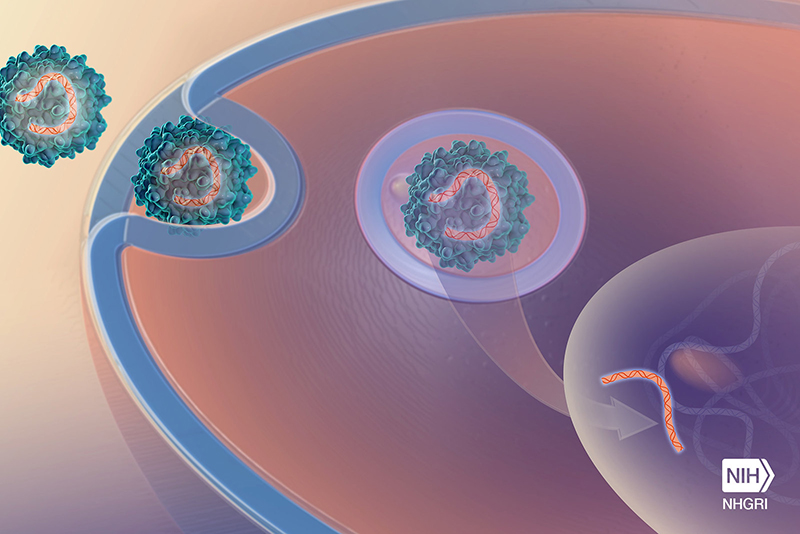Preclinical work by NIH investigators and colleagues lays foundation for clinical trial

Credit: NIH/National Human Genome Research Institute
A research team including National Institutes of Health scientists has developed a potential gene therapy for hereditary spastic paraplegia 50 (SPG50), a rare childhood-onset neurodegenerative disorder that leads to developmental delays, cognitive impairment, and eventual paralysis. The condition is caused by mutations in a single gene known as AP4M1. The team designed an investigational therapy to deliver a functioning AP4M1 gene to the cells of the central nervous system.
Scientists in the Bonifacino Lab at NIH’s Eunice Kennedy Shriver National Institute of Child Health and Human Development (NICHD) worked with cells derived from patients with SPG50 to help establish the experimental therapy’s potential to restore typical AP4M1 gene function. These findings and results from experiments in animal models provide the foundation for an early-stage clinical trial to evaluate the gene therapy in people with SPG50.
The research was led by Xin Chen, M.D., Ph.D., and Steven Gray, Ph.D., of the University of Texas Southwestern and funded by the CureSPG50 Foundation and NICHD. The study appears in the Journal of Clinical Investigation.
Background
The AP4M1 gene provides instructions for one of the four proteins comprising the adaptor protein 4 (AP-4) complex. AP-4 helps direct certain proteins to different locations within the cell, and loss of function in any of its four protein subunits leads to a form of hereditary spastic paraplegia. AP-4-associated hereditary spastic paraplegias are classified as “ultrarare” diseases. Approximately 300 cases have been identified worldwide, of which 90 are the SPG50 type. Although disease severity can vary, most individuals with SPG50 are non-verbal; never acquire the ability to walk, often becoming reliant on a wheelchair by the age of 10; and have microcephaly, epilepsy, and significant cognitive impairment.
Results
The scientists first developed a version of the gene therapy that could deliver a functional copy of AP4M1 to cultures of cells derived from patients with SPG50. Dr. Bonifacino and his NICHD colleagues Raffaella De Pace, Ph.D., and Rafael Mattera, Ph.D., carried out experiments with cells from two siblings with SPG50. Biochemical analyses suggested that the treatment effectively restored AP-4 levels and function in the cells. Independent experiments at Boston Children’s Hospital using cells from three additional SPG50 patients with different AP4M1 mutations yielded comparable results.
The research team next moved to animal studies, packaging the AP4M1 gene into a carrier—or vector— called adeno-associated virus type 9 (AAV9). Prior studies have suggested that AAV9, a non-disease-causing virus, serves as a safe and effective vector for gene therapies targeting the central nervous system. Treating mice lacking AP4M1 with AAV9/AP4M1 partially improved the animals’ behavioral issues. The benefits were greatest when the mice received high doses of AAV9/AP4M1 at a young age. Toxicology studies in mice, rats, and monkeys suggested that AAV9/AP4M1 is safe at doses predicted to be effective in humans with SPG50.
Significance
The work identified a potential treatment for SPG50 and laid the groundwork for a clinical trial to evaluate its safety and efficacy in people with the disease. The authors also hope that their work may provide a roadmap for researchers designing gene therapies for other neurological conditions.
Next Steps
A clinical trial evaluating the experimental gene therapy in people with SPG50 is underway.
Reference
Chen X et al. Intrathecal AAV9/AP4M1 gene therapy for hereditary spastic paraplegia 50 shows safety and efficacy in preclinical studies. Journal of Clinical Investigation DOI: 10.1172/JCI164575 (2023)

 BACK TO TOP
BACK TO TOP